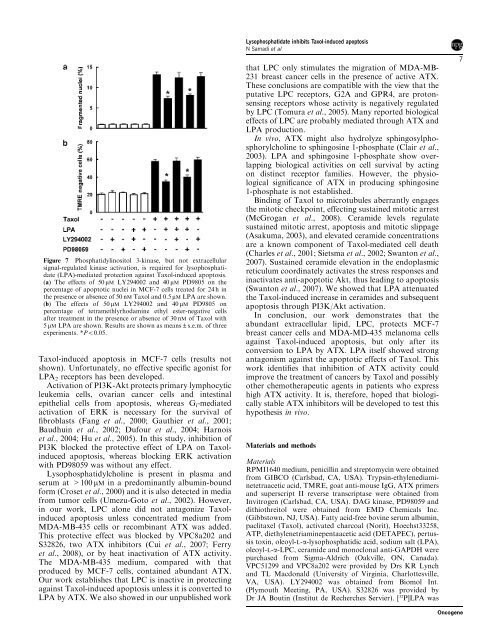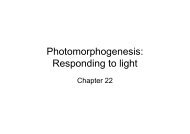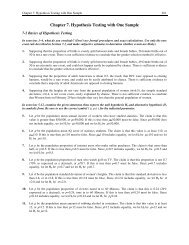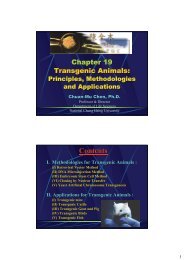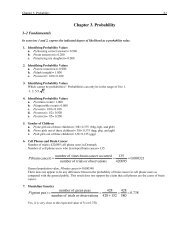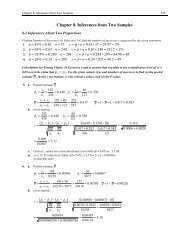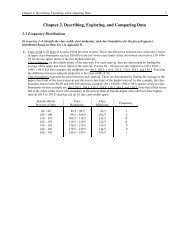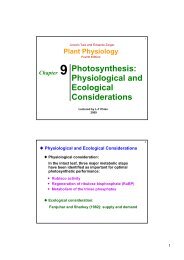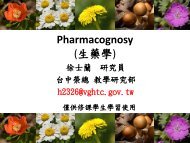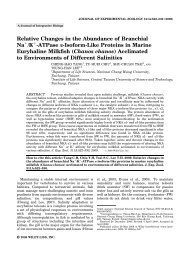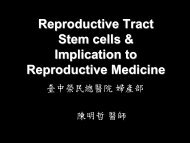Targeting cyclin B1 inhibits proliferation and sensitizes breast ...
Targeting cyclin B1 inhibits proliferation and sensitizes breast ...
Targeting cyclin B1 inhibits proliferation and sensitizes breast ...
You also want an ePaper? Increase the reach of your titles
YUMPU automatically turns print PDFs into web optimized ePapers that Google loves.
Figure 7 Phosphatidylinositol 3-kinase, but not extracellularsignal-regulated kinase activation, is required for lysophosphatidate(LPA)-mediated protection against Taxol-induced apoptosis.(a) The effects of 50 mM LY294002 <strong>and</strong> 40 mM PD9805 on thepercentage of apoptotic nuclei in MCF-7 cells treated for 24 h inthe presence or absence of 50 nM Taxol <strong>and</strong> 0.5 mM LPA are shown.(b) The effects of 50 mM LY294002 <strong>and</strong> 40 mM PD9805 onpercentage of tetramethlyrhodamine ethyl ester-negative cellsafter treatment in the presence or absence of 30 nM of Taxol with5 mM LPA are shown. Results are shown as means±s.e.m. of threeexperiments. *Po0.05.Taxol-induced apoptosis in MCF-7 cells (results notshown). Unfortunately, no effective specific agonist forLPA 2 receptors has been developed.Activation of PI3K-Akt protects primary lymphocyticleukemia cells, ovarian cancer cells <strong>and</strong> intestinalepithelial cells from apoptosis, whereas G i -mediatedactivation of ERK is necessary for the survival offibroblasts (Fang et al., 2000; Gauthier et al., 2001;Baudhuin et al., 2002; Dufour et al., 2004; Harnoiset al., 2004; Hu et al., 2005). In this study, inhibition ofPI3K blocked the protective effect of LPA on Taxolinducedapoptosis, whereas blocking ERK activationwith PD98059 was without any effect.Lysophosphatidylcholine is present in plasma <strong>and</strong>serum at >100 mM in a predominantly albumin-boundform (Croset et al., 2000) <strong>and</strong> it is also detected in mediafrom tumor cells (Umezu-Goto et al., 2002). However,in our work, LPC alone did not antagonize Taxolinducedapoptosis unless concentrated medium fromMDA-MB-435 cells or recombinant ATX was added.This protective effect was blocked by VPC8a202 <strong>and</strong>S32826, two ATX inhibitors (Cui et al., 2007; Ferryet al., 2008), or by heat inactivation of ATX activity.The MDA-MB-435 medium, compared with thatproduced by MCF-7 cells, contained abundant ATX.Our work establishes that LPC is inactive in protectingagainst Taxol-induced apoptosis unless it is converted toLPA by ATX. We also showed in our unpublished workLysophosphatidate <strong>inhibits</strong> Taxol-induced apoptosisN Samadi et althat LPC only stimulates the migration of MDA-MB-231 <strong>breast</strong> cancer cells in the presence of active ATX.These conclusions are compatible with the view that theputative LPC receptors, G2A <strong>and</strong> GPR4, are protonsensingreceptors whose activity is negatively regulatedby LPC (Tomura et al., 2005). Many reported biologicaleffects of LPC are probably mediated through ATX <strong>and</strong>LPA production.In vivo, ATX might also hydrolyze sphingosylphosphorylcholineto sphingosine 1-phosphate (Clair et al.,2003). LPA <strong>and</strong> sphingosine 1-phosphate show overlappingbiological activities on cell survival by actingon distinct receptor families. However, the physiologicalsignificance of ATX in producing sphingosine1-phosphate is not established.Binding of Taxol to microtubules aberrantly engagesthe mitotic checkpoint, effecting sustained mitotic arrest(McGrogan et al., 2008). Ceramide levels regulatesustained mitotic arrest, apoptosis <strong>and</strong> mitotic slippage(Asakuma, 2003), <strong>and</strong> elevated ceramide concentrationsare a known component of Taxol-mediated cell death(Charles et al., 2001; Sietsma et al., 2002; Swanton et al.,2007). Sustained ceramide elevation in the endoplasmicreticulum coordinately activates the stress responses <strong>and</strong>inactivates anti-apoptotic Akt, thus leading to apoptosis(Swanton et al., 2007). We showed that LPA attenuatedthe Taxol-induced increase in ceramides <strong>and</strong> subsequentapoptosis through PI3K/Akt activation.In conclusion, our work demonstrates that theabundant extracellular lipid, LPC, protects MCF-7<strong>breast</strong> cancer cells <strong>and</strong> MDA-MD-435 melanoma cellsagainst Taxol-induced apoptosis, but only after itsconversion to LPA by ATX. LPA itself showed strongantagonism against the apoptotic effects of Taxol. Thiswork identifies that inhibition of ATX activity couldimprove the treatment of cancers by Taxol <strong>and</strong> possiblyother chemotherapeutic agents in patients who expresshigh ATX activity. It is, therefore, hoped that biologicallystable ATX inhibitors will be developed to test thishypothesis in vivo.Materials <strong>and</strong> methodsMaterialsRPMI1640 medium, penicillin <strong>and</strong> streptomycin were obtainedfrom GIBCO (Carlsbad, CA, USA). Trypsin-ethylenediaminetetraaceticacid, TMRE, goat anti-mouse IgG, ATX primers<strong>and</strong> superscript II reverse transcriptase were obtained fromInvitrogen (Carlsbad, CA, USA). DAG kinase, PD98059 <strong>and</strong>dithiothreitol were obtained from EMD Chemicals Inc.(Gibbstown, NJ, USA). Fatty acid-free bovine serum albumin,paclitaxel (Taxol), activated charcoal (Norit), Hoechst33258,ATP, diethylenetriaminepentaacetic acid (DETAPEC), pertussistoxin, oleoyl-L-a-lysophosphatidic acid, sodium salt (LPA),oleoyl-L-a-LPC, ceramide <strong>and</strong> monoclonal anti-GAPDH werepurchased from Sigma-Aldrich (Oakville, ON, Canada).VPC51299 <strong>and</strong> VPC8a202 were provided by Drs KR Lynch<strong>and</strong> TL Macdonald (University of Virginia, Charlottesville,VA, USA). LY294002 was obtained from Biomol Int.(Plymouth Meeting, PA, USA). S32826 was provided byDr JA Boutin (Institut de Recherches Servier). [ 32 P]LPA was7Oncogene


